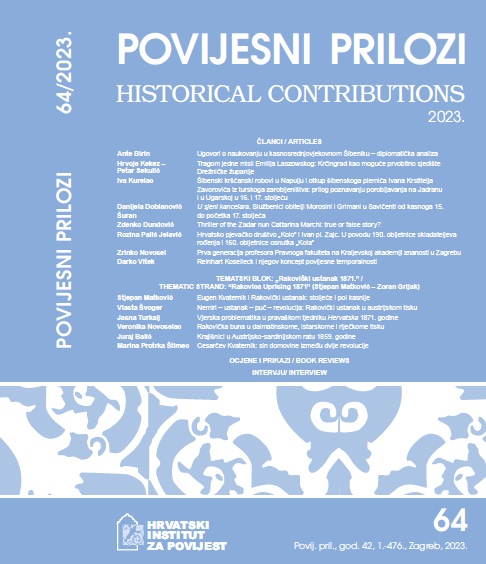Unrest – Uprising – Coup – Revolution: Rakovica Uprising in the Austrian Press
DOI:
https://doi.org/10.22586/pp.v42i64.25050Keywords:
Rakovica Uprisnig in 1871, German-language newspapers, Kingdom of Croatia and Slavonia, Austro-Hungarian MonarchyAbstract
The paper analyses the reception of the Rakovica Uprising in German-language newspapers published in the Austrian part of the Austro-Hungarian Monarchy. It investigates which newspapers reported on the uprising in Rakovica in October 1871 and how they covered the event. The analysis encompasses the types of texts used by individual newspaper editorial offices to report on the uprising in the Military Frontier, including reports with or without commentary, articles discussing the causes and potential consequences of the uprising, telegraph news, and field letters. It also examines the sources from which the newspapers obtained information, such as texts in other newspapers, telegrams from official bodies, and reports from their own correspondents. The analysis considers various aspects of the uprising that were written about. By examining the placement of texts about the events in the Ogulin Regiment within specific newspapers, it is possible to assess the importance attributed to the events by the editors. The analysis further explores the reception of the main protagonists of the uprising, primarily Eugen Kvaternik, and the significance of the uprising in the political context of the Austro-Hungarian Monarchy, as interpreted by the Austrian press of the time. Despite some shortcomings in reporting, tendentious approach, and limited objectivity, with a few exceptions, German-language newspapers from the Austrian part of the Monarchy remain a valuable and interesting historical source for understanding the reception of the Rakovica Uprising and its main protagonists from the perspective of Austrian politics and within a broader political context.
Downloads
Published
How to Cite
Issue
Section
License
Copyright (c) 2023 Authors and journal

This work is licensed under a Creative Commons Attribution-NonCommercial 4.0 International License.







